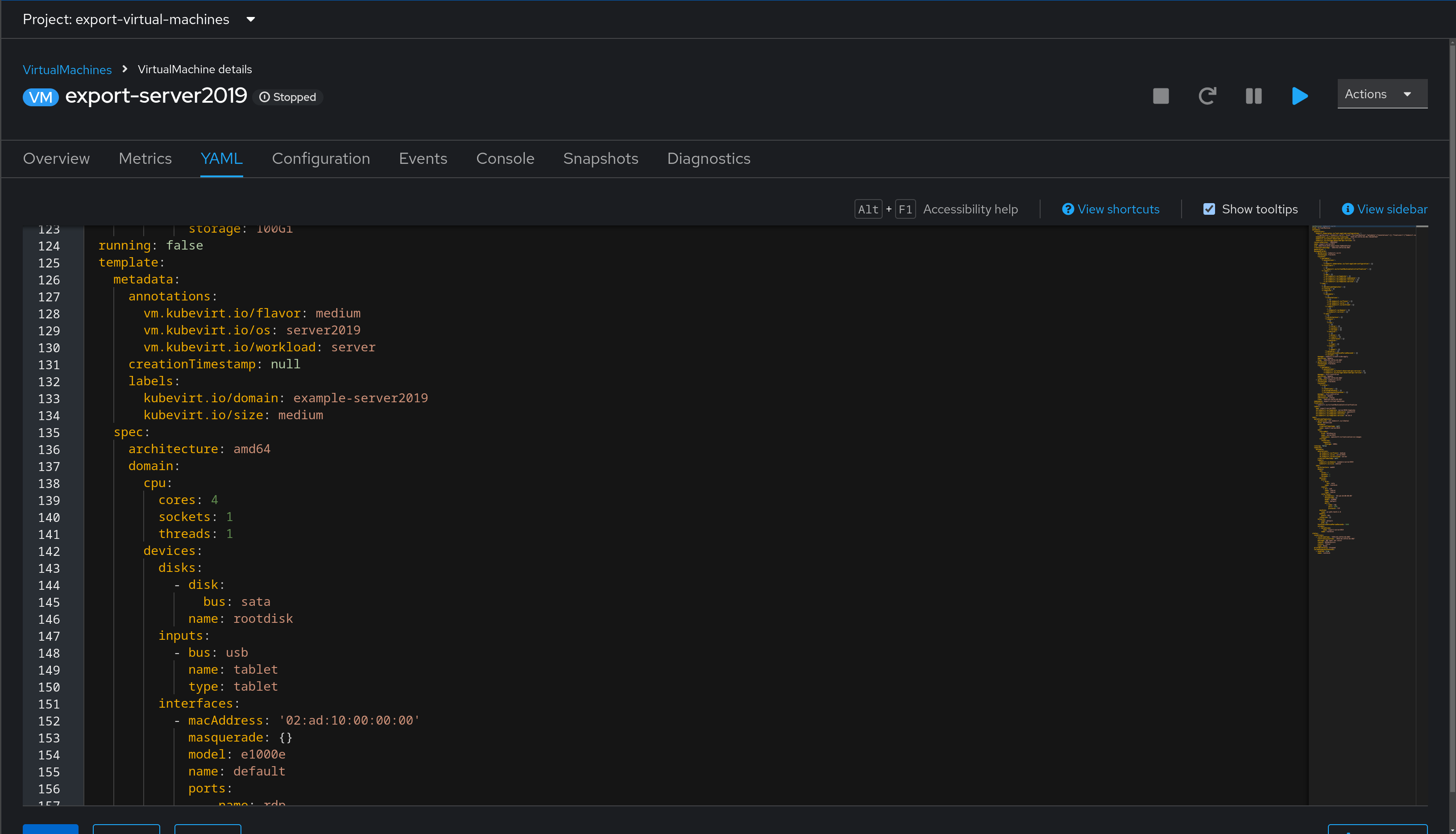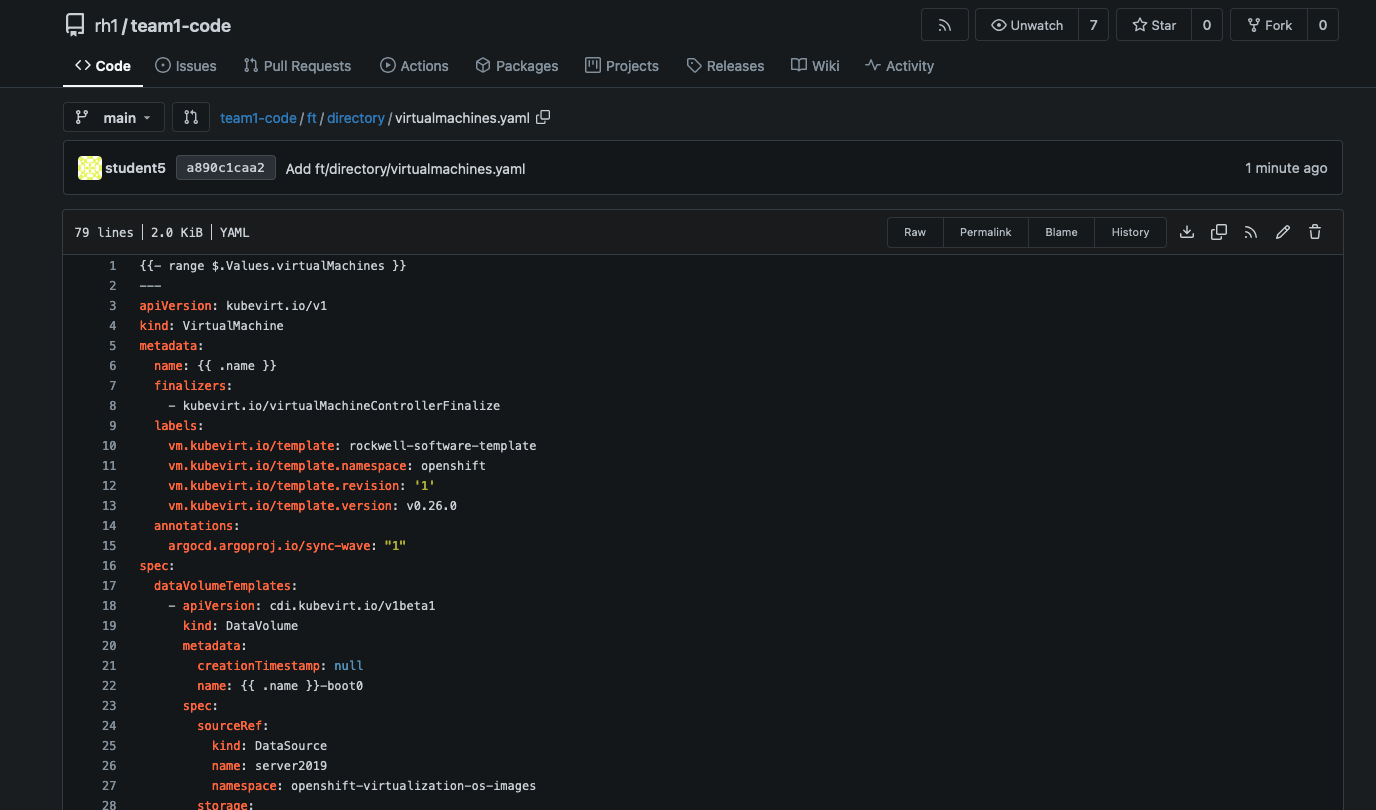Workshop Exercise 1.2 - Adding Virtual Machine Templates
Table of Contents
- Objective
- Step 1 - Investigating Virtual Machines
- Step 2 - Creating a Base Values.yaml File
- Step 3 - Creating Virtual Machine Definition Templates
- Step 4 - Default Values within Templates
Objective
Note: Pictures used as reference
- Understand definitions for virtual machines
- Create a template that can be looped
Step 1 - Investigating Virtual Machines
As with everything else in OpenShift, virtual machines can be created and modified by using code instead of the web interface. This allows for managing them through a gitops flow, instead of manual modifications.
For example, this is a snippet of a virtual machine’s definition:

In the screenshot, the virtual machine configuration is shown as code.
An example virtual machine has been created for you, and is located in your team namespace. To begin reviewing it, access the OpenShift web console using the URL and credentials from your student page. Then, navigate to Virtualization > VirtualMachines > example-server2019. Select the YAML tab to view the yaml definition of the virtual machine. This can be used as a base for building other virtual machine definitions.
Step 2 - Creating a Base Values.yaml File
Values that are used by templates can be placed into a file called values.yaml within the chart directory, which helm will automatically look for and use. These can be overriden if needed, but for our purposes, a simple values file will work.
Within the factorytalk directory in our code repo, create a new file named values.yaml, and add the following content:
---
virtualMachines:
- name: cs01
partOf: codesys-ide
operatingSystem: server2019
virtualMachinesCentOS:
- name: cn01
partOf: codesys-ide
These values will be used by the template in the next step to create the specified virtual machines.
Once complete, be sure to save the file, or if working within an IDE, commit and push.

Step 3 - Creating Virtual Machine Definition Templates
Since we’ll be creating two virtual machines that are nearly identical, we can create one template, and use the range function with helm to have it template out 1 virtual machines.
All values live under the .Values key, so the path to our list of virtual machines is: .Values.virtualMachines. Since we have a list, we can use the range function to iterate over the items within the list, and helm will render out the template accordingly.
Create a new directory within the chart directory called templates, and within it create a new file called virtualmachines.yaml.
The following combines the example virtual machine definition from earlier, along with the templating functions and values from our values.yaml file.
A quick note: when using certain functions within helm, the scope of variables can change. Wthin the range function, we “enter” the specific item, and can then reference the contents using a short notation.
We can think of this like a for loop, iterating over the items in the list.
Here’s some psudocode with some notes:
# Loop over every item in the list
for item in virtualMachines; do
# Since we're now "in" the first item, our values move from .Values.virtualMachines[0].name to just .name
echo .name
# Same idea, from .Values.virtualMachines[0].partOf to just .partOf
echo .partOf
done
To put that into practice, here’s our virtual machine definition combined with the range function, based on what’s in our values.yaml file from earlier:
{{- range $.Values.virtualMachines }}
---
apiVersion: kubevirt.io/v1
kind: VirtualMachine
metadata:
name: {{ .name }}
finalizers:
- kubevirt.io/virtualMachineControllerFinalize
labels:
vm.kubevirt.io/template: rockwell-software-template
vm.kubevirt.io/template.namespace: openshift
vm.kubevirt.io/template.revision: '1'
vm.kubevirt.io/template.version: v0.26.0
annotations:
argocd.argoproj.io/sync-wave: "1"
spec:
dataVolumeTemplates:
- apiVersion: cdi.kubevirt.io/v1beta1
kind: DataVolume
metadata:
creationTimestamp: null
name: {{ .name }}-boot0
spec:
sourceRef:
kind: DataSource
name: rockwell-software
namespace: openshift-virtualization-os-images
storage:
resources:
requests:
storage: 100Gi
running: true
template:
metadata:
annotations:
vm.kubevirt.io/flavor: medium
vm.kubevirt.io/os: {{ .operatingSystem }}
vm.kubevirt.io/workload: server
labels:
kubevirt.io/domain: {{ .name }}
kubevirt.io/size: medium
app.kubernetes.io/name: {{ .name }}
app.kubernetes.io/part-of: {{ .partOf }}
spec:
architecture: amd64
domain:
cpu:
cores: 1
sockets: {{ .cpuCores | default "4" }}
threads: 1
devices:
disks:
- disk:
bus: sata
name: rootdisk
inputs:
- bus: usb
name: tablet
type: tablet
interfaces:
- name: default
masquerade: {}
model: e1000e
ports:
- name: winrm
port: 5985
machine:
type: pc-q35-rhel9.2.0
memory:
guest: {{ .memory | default "8Gi" }}
networks:
- name: default
pod: {}
terminationGracePeriodSeconds: 3600
volumes:
- dataVolume:
name: {{ .name }}-boot0
name: rootdisk
{{- end }}
Be sure to save this file once done editing, or if working within an code editor, commit and push.

Step 4 - Default Values within Templates
You may have noticed a few lines in the virtual machine template earlier that appear to be referencing values that weren’t defined in our values.yaml file, and had a pipe after them.
sockets:
guest:
Another feature within helm templates is the ability to transform inputs, or to assign default values if nothing is specified. Here, defaults of 4 sockets and 8Gi of memory are set as defaults, and since our values.yaml file does not specify these values, the defaults will be applied.
Should we want to override these values, we simply need to define them in our values.yaml file. For example, to have our first virtual machine have more resources and let the second use the defaults, we could modify our values.yaml file accordingly:
---
virtualMachines:
- name: cs01
partOf: codesys
operatingSystem: server2019
cpuCores: 8
memory: 16Gi
This is not required for our use case, but feel free to modify your values.yaml file if desired.
Step 3 Setup PLC Debug HOST
PLC - Programmable Logic Controlller - common in Industrial Autmation systems in manufacturing. Add this to the virtual-machines.yaml
yaml` file from earlier:
{{- range $.Values.virtualMachinesCentOS }}
---
apiVersion: kubevirt.io/v1
kind: VirtualMachine
metadata:
name: {{ .name }}
finalizers:
- kubevirt.io/virtualMachineControllerFinalize
labels:
vm.kubevirt.io/template: centos-stream9-server-small
vm.kubevirt.io/template.namespace: openshift
vm.kubevirt.io/template.revision: '1'
vm.kubevirt.io/template.version: v0.26.0
annotations:
argocd.argoproj.io/sync-wave: "1"
spec:
dataVolumeTemplates:
- apiVersion: cdi.kubevirt.io/v1beta1
kind: DataVolume
metadata:
creationTimestamp: null
name: {{ .name }}-boot0
spec:
sourceRef:
kind: DataSource
name: centos-stream9
namespace: openshift-virtualization-os-images
storage:
resources:
requests:
storage: 30Gi
running: true
template:
metadata:
annotations:
vm.kubevirt.io/flavor: medium
vm.kubevirt.io/os: {{ .operatingSystem }}
vm.kubevirt.io/workload: server
labels:
kubevirt.io/domain: {{ .name }}
kubevirt.io/size: medium
app.kubernetes.io/name: {{ .name }}
app.kubernetes.io/part-of: {{ .partOf }}
spec:
architecture: amd64
domain:
cpu:
cores: 1
sockets: {{ .cpuCores | default "4" }}
threads: 1
devices:
disks:
- disk:
bus: sata
name: rootdisk
- disk:
bus: virtio
name: cloudinitdisk
inputs:
- bus: usb
name: tablet
type: tablet
interfaces:
- name: default
masquerade: {}
model: e1000e
ports:
- name: ssh
port: 22
machine:
type: pc-q35-rhel9.2.0
memory:
guest: {{ .memory | default "8Gi" }}
networks:
- name: default
pod: {}
terminationGracePeriodSeconds: 3600
volumes:
- dataVolume:
name: {{ .name }}-boot0
name: rootdisk
- cloudInitNoCloud:
userData: |-
#cloud-config
user: centos
password: 8bht-5u5i-m3vg
chpasswd: { expire: False }
name: cloudinitdisk
{{- end }}
Once the the VM is running, check OpenShift Console (guest credentials and login) .

Once logged in, we will install podman.
sudo dnf install podman
Navigation
| Previous Exercise | Next Exercise |
